Unit 35: Developing Individuals, Teams, and Organisations - Report
VerifiedAdded on 2024/06/11
|22
|4242
|382
Report
AI Summary
This report provides a detailed analysis of developing individuals, teams, and organizations, focusing on the role of HR professionals, essential skills, and behaviors. It includes a personal skills audit and a professional development plan. The report examines factors for implementing inclusive learning and development to drive sustainable business performance, differentiating between organizational and individual learning. It applies learning cycle theories to continuous professional development and explores high-performance working (HPW) contributions to employee engagement and competitive advantage, using Whirlpool as a case study. The evaluation of performance management, collaborative working, and effective communication in supporting a high-performance culture concludes the report. Desklib provides access to this and other solved assignments.
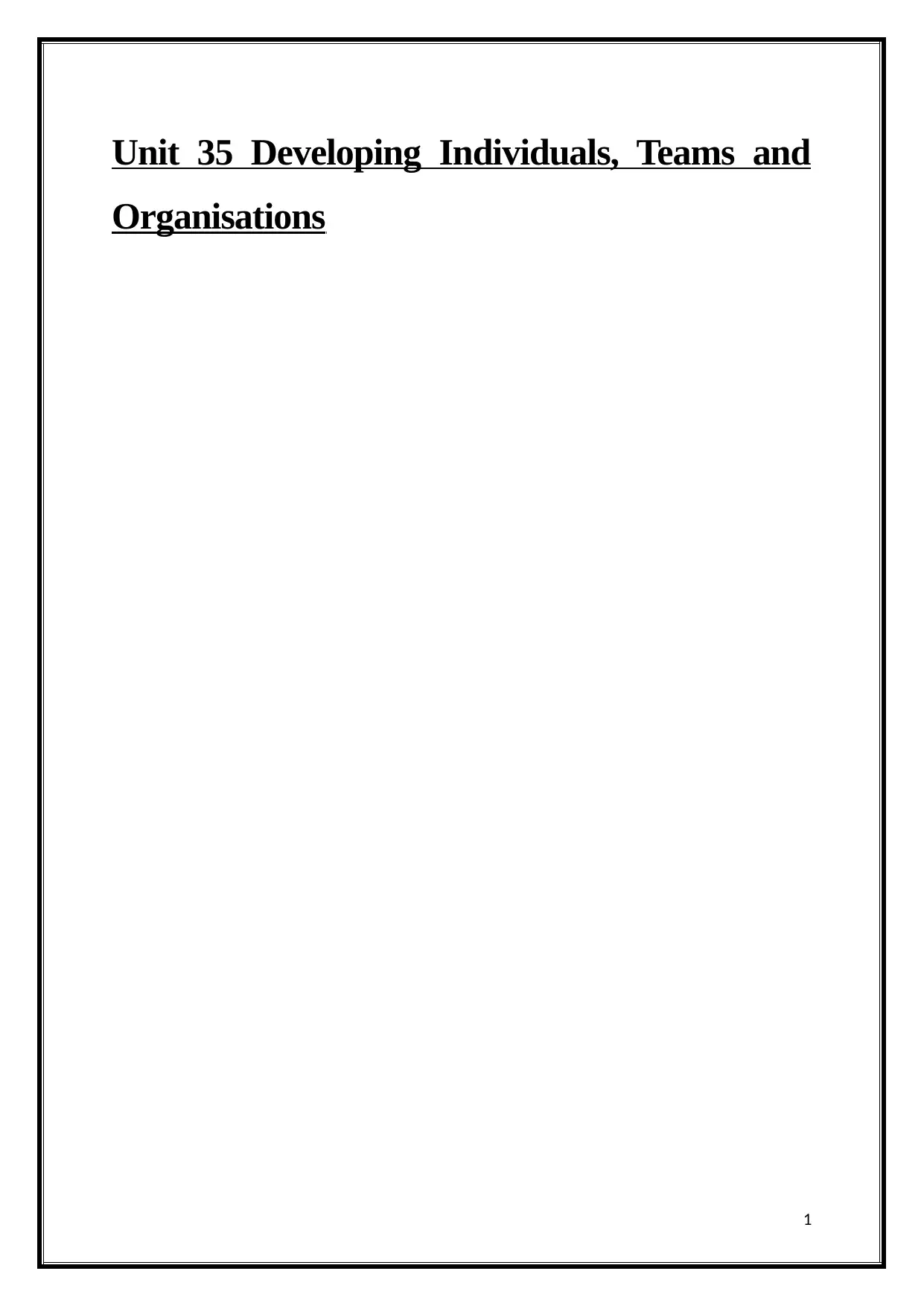
Unit 35 Developing Individuals, Teams and
Organisations
1
Organisations
1
Paraphrase This Document
Need a fresh take? Get an instant paraphrase of this document with our AI Paraphraser
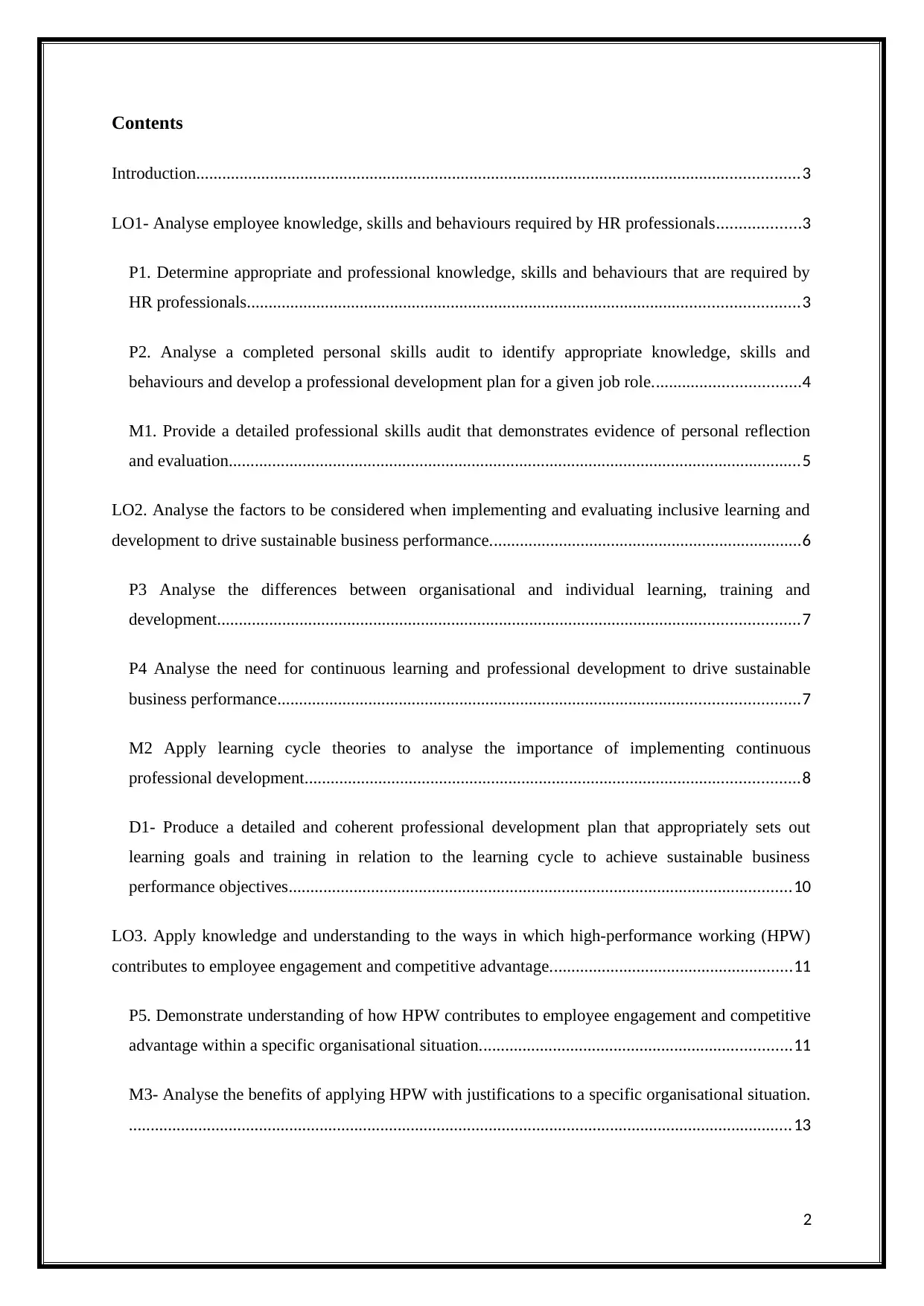
Contents
Introduction...........................................................................................................................................3
LO1- Analyse employee knowledge, skills and behaviours required by HR professionals...................3
P1. Determine appropriate and professional knowledge, skills and behaviours that are required by
HR professionals...............................................................................................................................3
P2. Analyse a completed personal skills audit to identify appropriate knowledge, skills and
behaviours and develop a professional development plan for a given job role..................................4
M1. Provide a detailed professional skills audit that demonstrates evidence of personal reflection
and evaluation....................................................................................................................................5
LO2. Analyse the factors to be considered when implementing and evaluating inclusive learning and
development to drive sustainable business performance........................................................................6
P3 Analyse the differences between organisational and individual learning, training and
development......................................................................................................................................7
P4 Analyse the need for continuous learning and professional development to drive sustainable
business performance........................................................................................................................7
M2 Apply learning cycle theories to analyse the importance of implementing continuous
professional development..................................................................................................................8
D1- Produce a detailed and coherent professional development plan that appropriately sets out
learning goals and training in relation to the learning cycle to achieve sustainable business
performance objectives....................................................................................................................10
LO3. Apply knowledge and understanding to the ways in which high-performance working (HPW)
contributes to employee engagement and competitive advantage........................................................11
P5. Demonstrate understanding of how HPW contributes to employee engagement and competitive
advantage within a specific organisational situation........................................................................11
M3- Analyse the benefits of applying HPW with justifications to a specific organisational situation.
.........................................................................................................................................................13
2
Introduction...........................................................................................................................................3
LO1- Analyse employee knowledge, skills and behaviours required by HR professionals...................3
P1. Determine appropriate and professional knowledge, skills and behaviours that are required by
HR professionals...............................................................................................................................3
P2. Analyse a completed personal skills audit to identify appropriate knowledge, skills and
behaviours and develop a professional development plan for a given job role..................................4
M1. Provide a detailed professional skills audit that demonstrates evidence of personal reflection
and evaluation....................................................................................................................................5
LO2. Analyse the factors to be considered when implementing and evaluating inclusive learning and
development to drive sustainable business performance........................................................................6
P3 Analyse the differences between organisational and individual learning, training and
development......................................................................................................................................7
P4 Analyse the need for continuous learning and professional development to drive sustainable
business performance........................................................................................................................7
M2 Apply learning cycle theories to analyse the importance of implementing continuous
professional development..................................................................................................................8
D1- Produce a detailed and coherent professional development plan that appropriately sets out
learning goals and training in relation to the learning cycle to achieve sustainable business
performance objectives....................................................................................................................10
LO3. Apply knowledge and understanding to the ways in which high-performance working (HPW)
contributes to employee engagement and competitive advantage........................................................11
P5. Demonstrate understanding of how HPW contributes to employee engagement and competitive
advantage within a specific organisational situation........................................................................11
M3- Analyse the benefits of applying HPW with justifications to a specific organisational situation.
.........................................................................................................................................................13
2
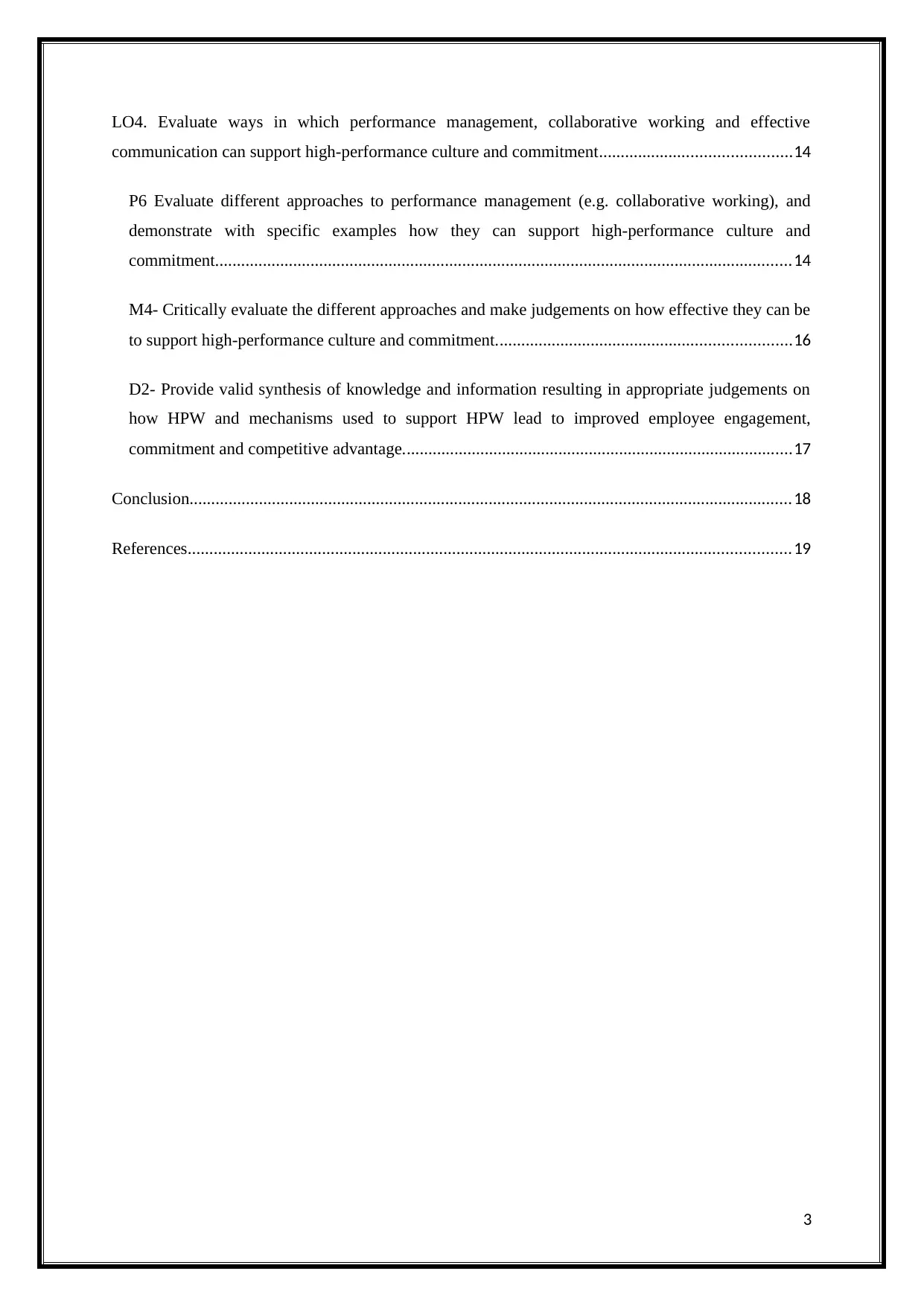
LO4. Evaluate ways in which performance management, collaborative working and effective
communication can support high-performance culture and commitment............................................14
P6 Evaluate different approaches to performance management (e.g. collaborative working), and
demonstrate with specific examples how they can support high-performance culture and
commitment.....................................................................................................................................14
M4- Critically evaluate the different approaches and make judgements on how effective they can be
to support high-performance culture and commitment....................................................................16
D2- Provide valid synthesis of knowledge and information resulting in appropriate judgements on
how HPW and mechanisms used to support HPW lead to improved employee engagement,
commitment and competitive advantage..........................................................................................17
Conclusion...........................................................................................................................................18
References...........................................................................................................................................19
3
communication can support high-performance culture and commitment............................................14
P6 Evaluate different approaches to performance management (e.g. collaborative working), and
demonstrate with specific examples how they can support high-performance culture and
commitment.....................................................................................................................................14
M4- Critically evaluate the different approaches and make judgements on how effective they can be
to support high-performance culture and commitment....................................................................16
D2- Provide valid synthesis of knowledge and information resulting in appropriate judgements on
how HPW and mechanisms used to support HPW lead to improved employee engagement,
commitment and competitive advantage..........................................................................................17
Conclusion...........................................................................................................................................18
References...........................................................................................................................................19
3
⊘ This is a preview!⊘
Do you want full access?
Subscribe today to unlock all pages.

Trusted by 1+ million students worldwide
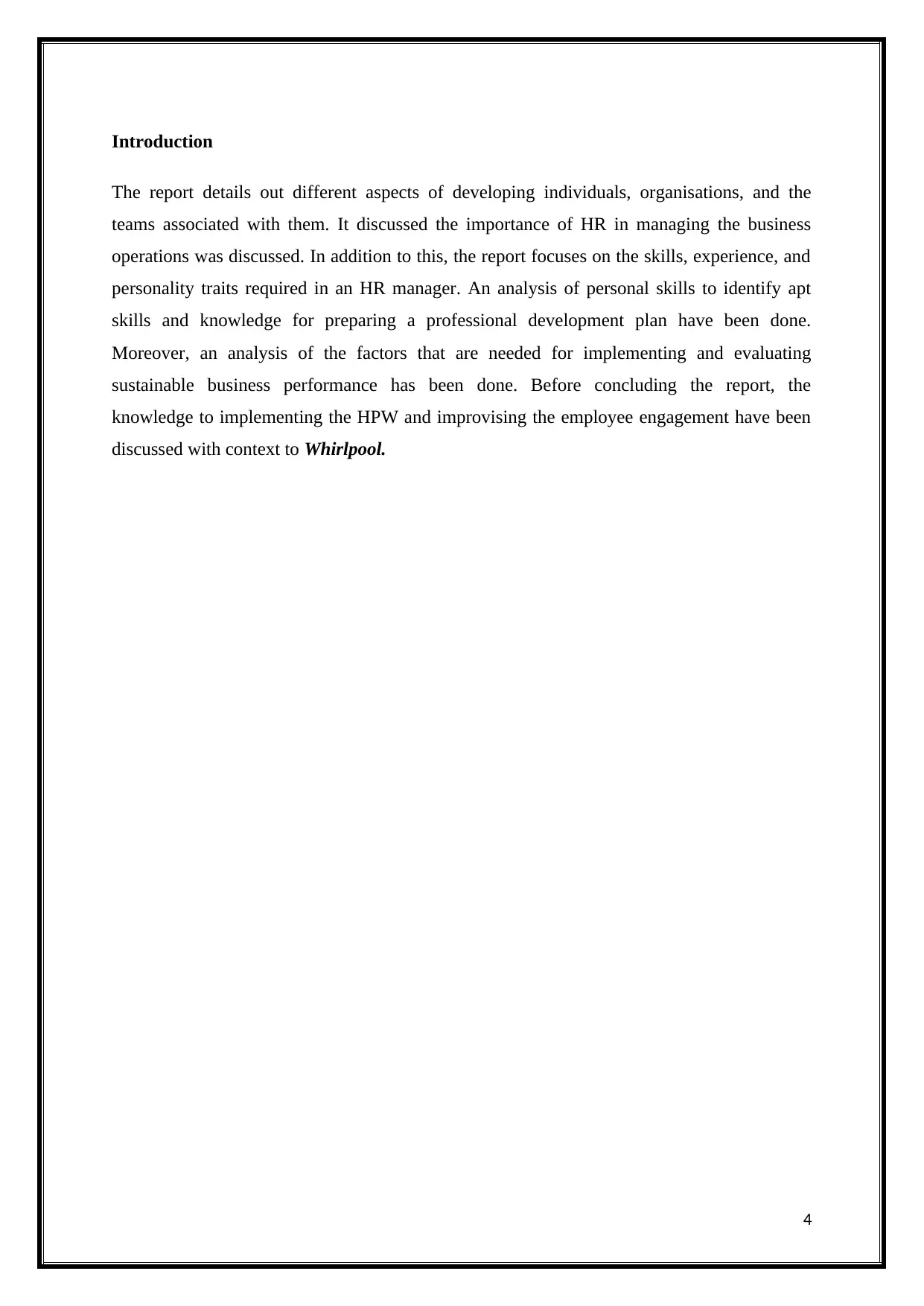
Introduction
The report details out different aspects of developing individuals, organisations, and the
teams associated with them. It discussed the importance of HR in managing the business
operations was discussed. In addition to this, the report focuses on the skills, experience, and
personality traits required in an HR manager. An analysis of personal skills to identify apt
skills and knowledge for preparing a professional development plan have been done.
Moreover, an analysis of the factors that are needed for implementing and evaluating
sustainable business performance has been done. Before concluding the report, the
knowledge to implementing the HPW and improvising the employee engagement have been
discussed with context to Whirlpool.
4
The report details out different aspects of developing individuals, organisations, and the
teams associated with them. It discussed the importance of HR in managing the business
operations was discussed. In addition to this, the report focuses on the skills, experience, and
personality traits required in an HR manager. An analysis of personal skills to identify apt
skills and knowledge for preparing a professional development plan have been done.
Moreover, an analysis of the factors that are needed for implementing and evaluating
sustainable business performance has been done. Before concluding the report, the
knowledge to implementing the HPW and improvising the employee engagement have been
discussed with context to Whirlpool.
4
Paraphrase This Document
Need a fresh take? Get an instant paraphrase of this document with our AI Paraphraser
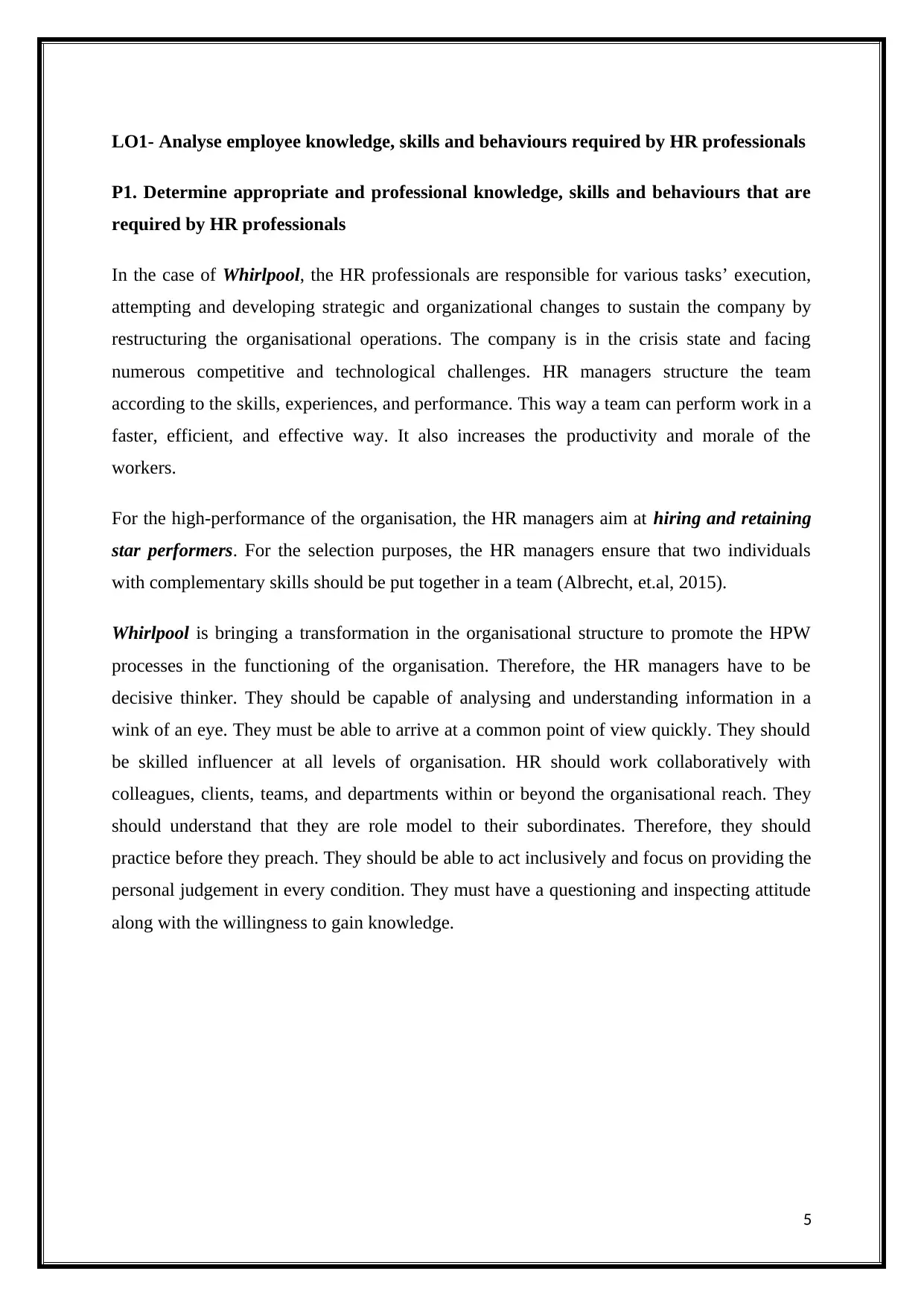
LO1- Analyse employee knowledge, skills and behaviours required by HR professionals
P1. Determine appropriate and professional knowledge, skills and behaviours that are
required by HR professionals
In the case of Whirlpool, the HR professionals are responsible for various tasks’ execution,
attempting and developing strategic and organizational changes to sustain the company by
restructuring the organisational operations. The company is in the crisis state and facing
numerous competitive and technological challenges. HR managers structure the team
according to the skills, experiences, and performance. This way a team can perform work in a
faster, efficient, and effective way. It also increases the productivity and morale of the
workers.
For the high-performance of the organisation, the HR managers aim at hiring and retaining
star performers. For the selection purposes, the HR managers ensure that two individuals
with complementary skills should be put together in a team (Albrecht, et.al, 2015).
Whirlpool is bringing a transformation in the organisational structure to promote the HPW
processes in the functioning of the organisation. Therefore, the HR managers have to be
decisive thinker. They should be capable of analysing and understanding information in a
wink of an eye. They must be able to arrive at a common point of view quickly. They should
be skilled influencer at all levels of organisation. HR should work collaboratively with
colleagues, clients, teams, and departments within or beyond the organisational reach. They
should understand that they are role model to their subordinates. Therefore, they should
practice before they preach. They should be able to act inclusively and focus on providing the
personal judgement in every condition. They must have a questioning and inspecting attitude
along with the willingness to gain knowledge.
5
P1. Determine appropriate and professional knowledge, skills and behaviours that are
required by HR professionals
In the case of Whirlpool, the HR professionals are responsible for various tasks’ execution,
attempting and developing strategic and organizational changes to sustain the company by
restructuring the organisational operations. The company is in the crisis state and facing
numerous competitive and technological challenges. HR managers structure the team
according to the skills, experiences, and performance. This way a team can perform work in a
faster, efficient, and effective way. It also increases the productivity and morale of the
workers.
For the high-performance of the organisation, the HR managers aim at hiring and retaining
star performers. For the selection purposes, the HR managers ensure that two individuals
with complementary skills should be put together in a team (Albrecht, et.al, 2015).
Whirlpool is bringing a transformation in the organisational structure to promote the HPW
processes in the functioning of the organisation. Therefore, the HR managers have to be
decisive thinker. They should be capable of analysing and understanding information in a
wink of an eye. They must be able to arrive at a common point of view quickly. They should
be skilled influencer at all levels of organisation. HR should work collaboratively with
colleagues, clients, teams, and departments within or beyond the organisational reach. They
should understand that they are role model to their subordinates. Therefore, they should
practice before they preach. They should be able to act inclusively and focus on providing the
personal judgement in every condition. They must have a questioning and inspecting attitude
along with the willingness to gain knowledge.
5
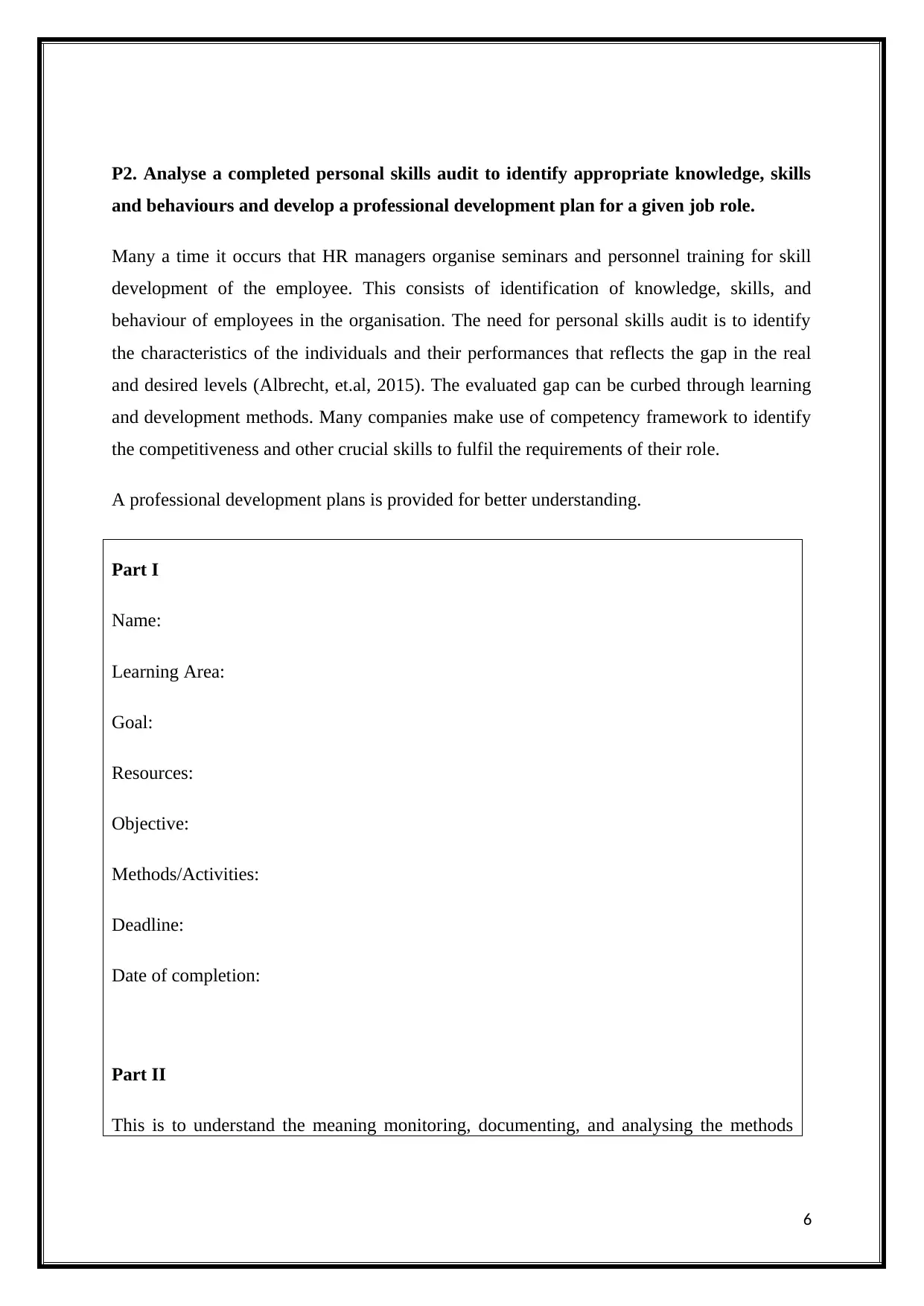
P2. Analyse a completed personal skills audit to identify appropriate knowledge, skills
and behaviours and develop a professional development plan for a given job role.
Many a time it occurs that HR managers organise seminars and personnel training for skill
development of the employee. This consists of identification of knowledge, skills, and
behaviour of employees in the organisation. The need for personal skills audit is to identify
the characteristics of the individuals and their performances that reflects the gap in the real
and desired levels (Albrecht, et.al, 2015). The evaluated gap can be curbed through learning
and development methods. Many companies make use of competency framework to identify
the competitiveness and other crucial skills to fulfil the requirements of their role.
A professional development plans is provided for better understanding.
Part I
Name:
Learning Area:
Goal:
Resources:
Objective:
Methods/Activities:
Deadline:
Date of completion:
Part II
This is to understand the meaning monitoring, documenting, and analysing the methods
6
and behaviours and develop a professional development plan for a given job role.
Many a time it occurs that HR managers organise seminars and personnel training for skill
development of the employee. This consists of identification of knowledge, skills, and
behaviour of employees in the organisation. The need for personal skills audit is to identify
the characteristics of the individuals and their performances that reflects the gap in the real
and desired levels (Albrecht, et.al, 2015). The evaluated gap can be curbed through learning
and development methods. Many companies make use of competency framework to identify
the competitiveness and other crucial skills to fulfil the requirements of their role.
A professional development plans is provided for better understanding.
Part I
Name:
Learning Area:
Goal:
Resources:
Objective:
Methods/Activities:
Deadline:
Date of completion:
Part II
This is to understand the meaning monitoring, documenting, and analysing the methods
6
⊘ This is a preview!⊘
Do you want full access?
Subscribe today to unlock all pages.

Trusted by 1+ million students worldwide
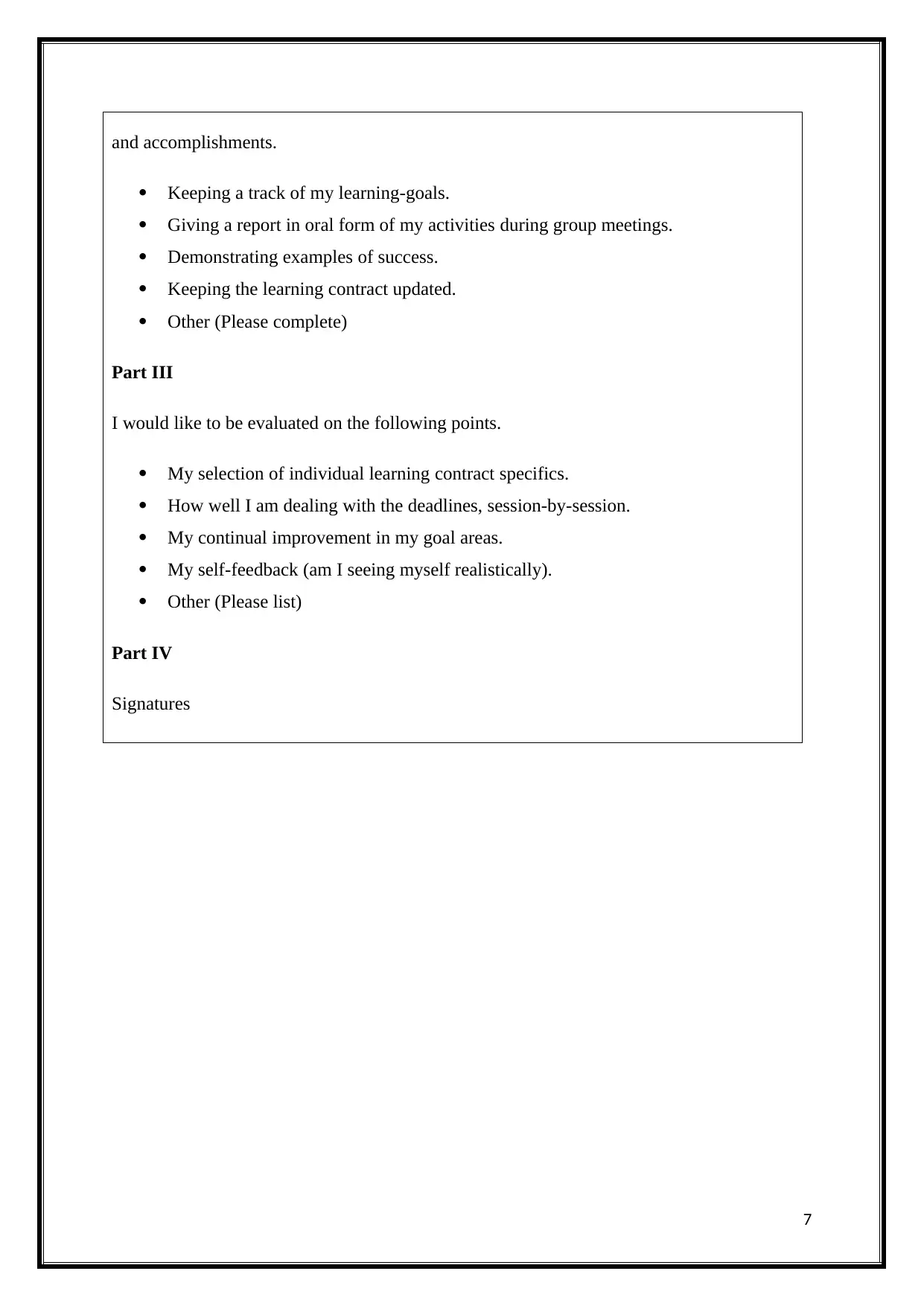
and accomplishments.
Keeping a track of my learning-goals.
Giving a report in oral form of my activities during group meetings.
Demonstrating examples of success.
Keeping the learning contract updated.
Other (Please complete)
Part III
I would like to be evaluated on the following points.
My selection of individual learning contract specifics.
How well I am dealing with the deadlines, session-by-session.
My continual improvement in my goal areas.
My self-feedback (am I seeing myself realistically).
Other (Please list)
Part IV
Signatures
7
Keeping a track of my learning-goals.
Giving a report in oral form of my activities during group meetings.
Demonstrating examples of success.
Keeping the learning contract updated.
Other (Please complete)
Part III
I would like to be evaluated on the following points.
My selection of individual learning contract specifics.
How well I am dealing with the deadlines, session-by-session.
My continual improvement in my goal areas.
My self-feedback (am I seeing myself realistically).
Other (Please list)
Part IV
Signatures
7
Paraphrase This Document
Need a fresh take? Get an instant paraphrase of this document with our AI Paraphraser
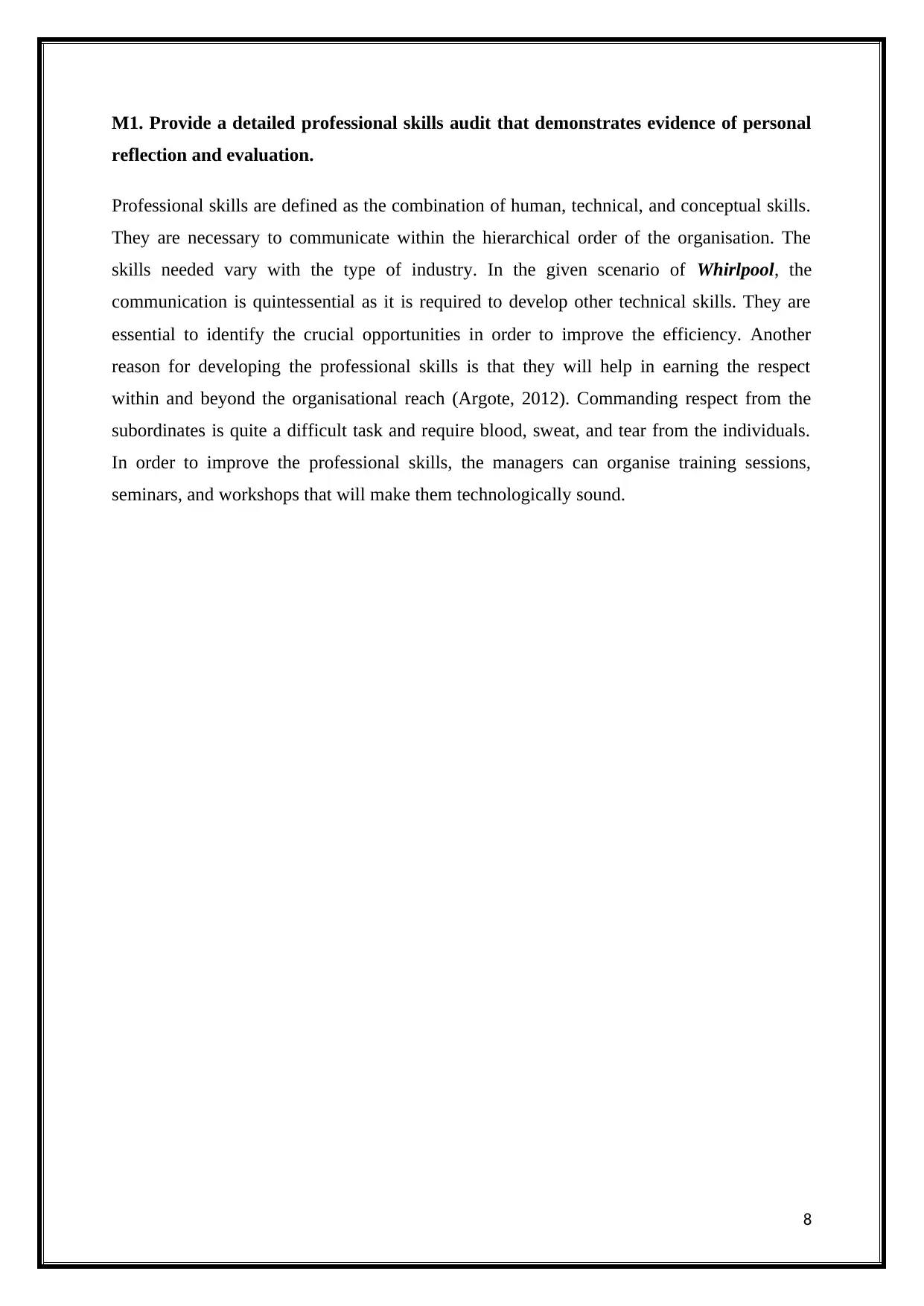
M1. Provide a detailed professional skills audit that demonstrates evidence of personal
reflection and evaluation.
Professional skills are defined as the combination of human, technical, and conceptual skills.
They are necessary to communicate within the hierarchical order of the organisation. The
skills needed vary with the type of industry. In the given scenario of Whirlpool, the
communication is quintessential as it is required to develop other technical skills. They are
essential to identify the crucial opportunities in order to improve the efficiency. Another
reason for developing the professional skills is that they will help in earning the respect
within and beyond the organisational reach (Argote, 2012). Commanding respect from the
subordinates is quite a difficult task and require blood, sweat, and tear from the individuals.
In order to improve the professional skills, the managers can organise training sessions,
seminars, and workshops that will make them technologically sound.
8
reflection and evaluation.
Professional skills are defined as the combination of human, technical, and conceptual skills.
They are necessary to communicate within the hierarchical order of the organisation. The
skills needed vary with the type of industry. In the given scenario of Whirlpool, the
communication is quintessential as it is required to develop other technical skills. They are
essential to identify the crucial opportunities in order to improve the efficiency. Another
reason for developing the professional skills is that they will help in earning the respect
within and beyond the organisational reach (Argote, 2012). Commanding respect from the
subordinates is quite a difficult task and require blood, sweat, and tear from the individuals.
In order to improve the professional skills, the managers can organise training sessions,
seminars, and workshops that will make them technologically sound.
8
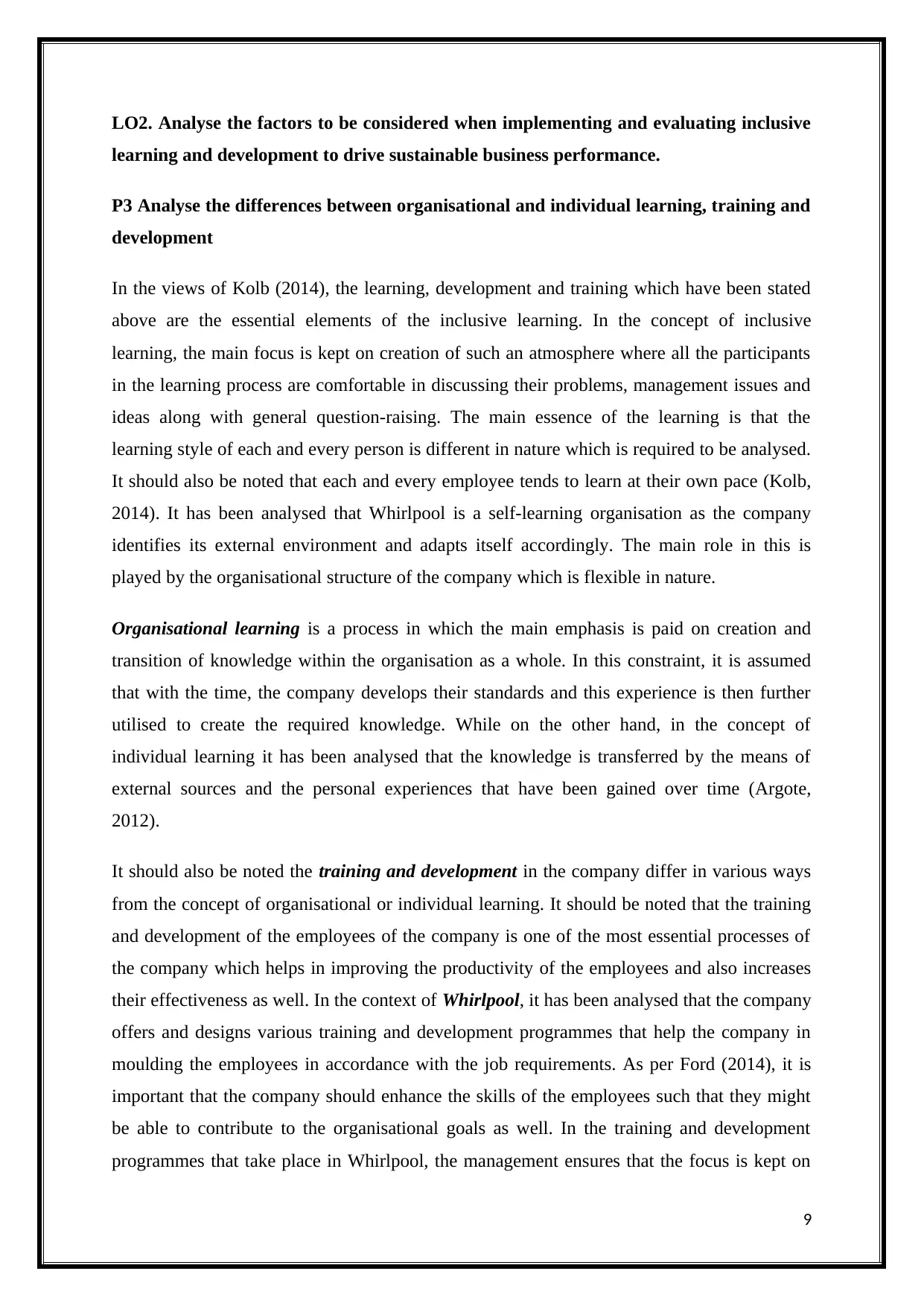
LO2. Analyse the factors to be considered when implementing and evaluating inclusive
learning and development to drive sustainable business performance.
P3 Analyse the differences between organisational and individual learning, training and
development
In the views of Kolb (2014), the learning, development and training which have been stated
above are the essential elements of the inclusive learning. In the concept of inclusive
learning, the main focus is kept on creation of such an atmosphere where all the participants
in the learning process are comfortable in discussing their problems, management issues and
ideas along with general question-raising. The main essence of the learning is that the
learning style of each and every person is different in nature which is required to be analysed.
It should also be noted that each and every employee tends to learn at their own pace (Kolb,
2014). It has been analysed that Whirlpool is a self-learning organisation as the company
identifies its external environment and adapts itself accordingly. The main role in this is
played by the organisational structure of the company which is flexible in nature.
Organisational learning is a process in which the main emphasis is paid on creation and
transition of knowledge within the organisation as a whole. In this constraint, it is assumed
that with the time, the company develops their standards and this experience is then further
utilised to create the required knowledge. While on the other hand, in the concept of
individual learning it has been analysed that the knowledge is transferred by the means of
external sources and the personal experiences that have been gained over time (Argote,
2012).
It should also be noted the training and development in the company differ in various ways
from the concept of organisational or individual learning. It should be noted that the training
and development of the employees of the company is one of the most essential processes of
the company which helps in improving the productivity of the employees and also increases
their effectiveness as well. In the context of Whirlpool, it has been analysed that the company
offers and designs various training and development programmes that help the company in
moulding the employees in accordance with the job requirements. As per Ford (2014), it is
important that the company should enhance the skills of the employees such that they might
be able to contribute to the organisational goals as well. In the training and development
programmes that take place in Whirlpool, the management ensures that the focus is kept on
9
learning and development to drive sustainable business performance.
P3 Analyse the differences between organisational and individual learning, training and
development
In the views of Kolb (2014), the learning, development and training which have been stated
above are the essential elements of the inclusive learning. In the concept of inclusive
learning, the main focus is kept on creation of such an atmosphere where all the participants
in the learning process are comfortable in discussing their problems, management issues and
ideas along with general question-raising. The main essence of the learning is that the
learning style of each and every person is different in nature which is required to be analysed.
It should also be noted that each and every employee tends to learn at their own pace (Kolb,
2014). It has been analysed that Whirlpool is a self-learning organisation as the company
identifies its external environment and adapts itself accordingly. The main role in this is
played by the organisational structure of the company which is flexible in nature.
Organisational learning is a process in which the main emphasis is paid on creation and
transition of knowledge within the organisation as a whole. In this constraint, it is assumed
that with the time, the company develops their standards and this experience is then further
utilised to create the required knowledge. While on the other hand, in the concept of
individual learning it has been analysed that the knowledge is transferred by the means of
external sources and the personal experiences that have been gained over time (Argote,
2012).
It should also be noted the training and development in the company differ in various ways
from the concept of organisational or individual learning. It should be noted that the training
and development of the employees of the company is one of the most essential processes of
the company which helps in improving the productivity of the employees and also increases
their effectiveness as well. In the context of Whirlpool, it has been analysed that the company
offers and designs various training and development programmes that help the company in
moulding the employees in accordance with the job requirements. As per Ford (2014), it is
important that the company should enhance the skills of the employees such that they might
be able to contribute to the organisational goals as well. In the training and development
programmes that take place in Whirlpool, the management ensures that the focus is kept on
9
⊘ This is a preview!⊘
Do you want full access?
Subscribe today to unlock all pages.

Trusted by 1+ million students worldwide
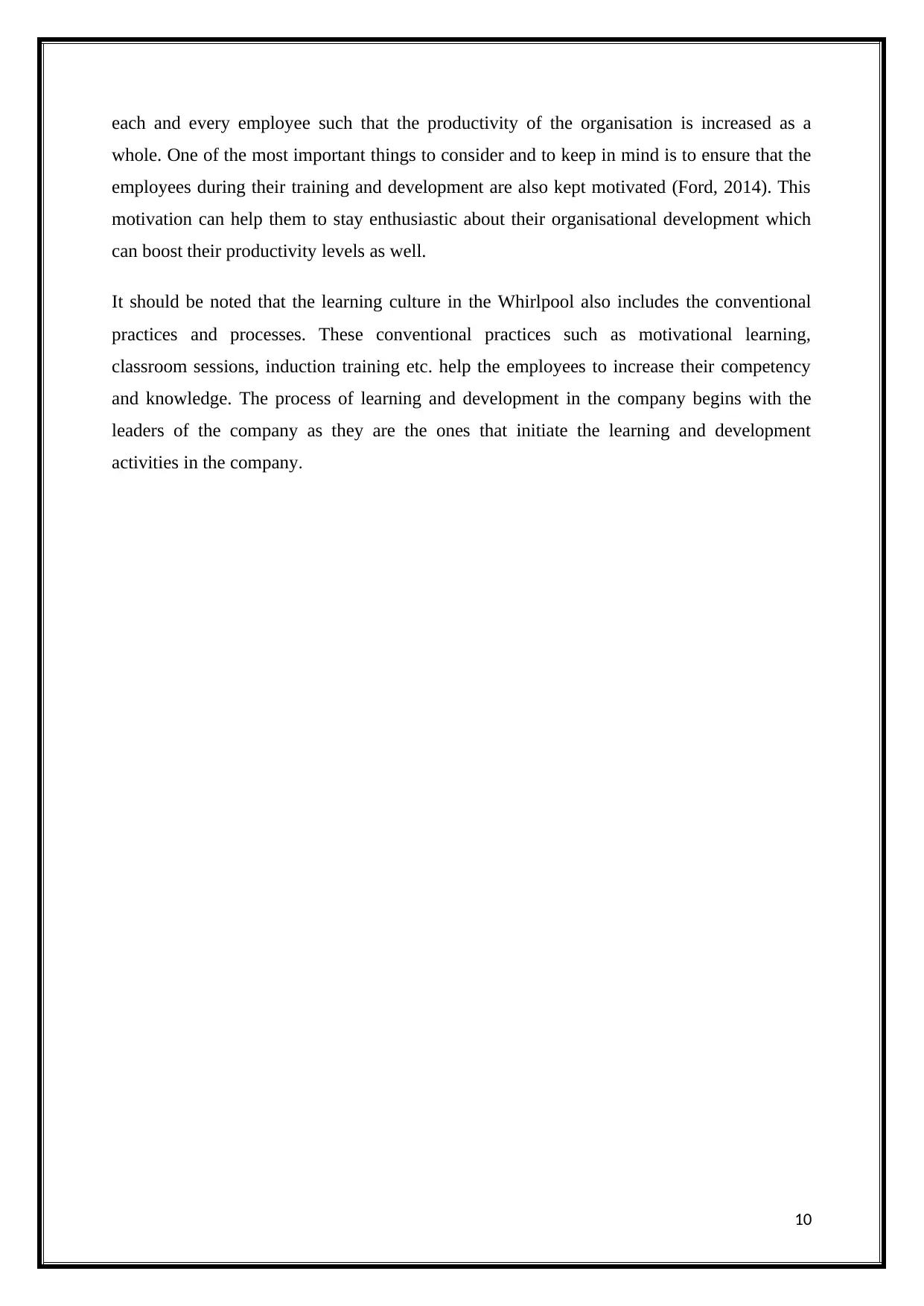
each and every employee such that the productivity of the organisation is increased as a
whole. One of the most important things to consider and to keep in mind is to ensure that the
employees during their training and development are also kept motivated (Ford, 2014). This
motivation can help them to stay enthusiastic about their organisational development which
can boost their productivity levels as well.
It should be noted that the learning culture in the Whirlpool also includes the conventional
practices and processes. These conventional practices such as motivational learning,
classroom sessions, induction training etc. help the employees to increase their competency
and knowledge. The process of learning and development in the company begins with the
leaders of the company as they are the ones that initiate the learning and development
activities in the company.
10
whole. One of the most important things to consider and to keep in mind is to ensure that the
employees during their training and development are also kept motivated (Ford, 2014). This
motivation can help them to stay enthusiastic about their organisational development which
can boost their productivity levels as well.
It should be noted that the learning culture in the Whirlpool also includes the conventional
practices and processes. These conventional practices such as motivational learning,
classroom sessions, induction training etc. help the employees to increase their competency
and knowledge. The process of learning and development in the company begins with the
leaders of the company as they are the ones that initiate the learning and development
activities in the company.
10
Paraphrase This Document
Need a fresh take? Get an instant paraphrase of this document with our AI Paraphraser
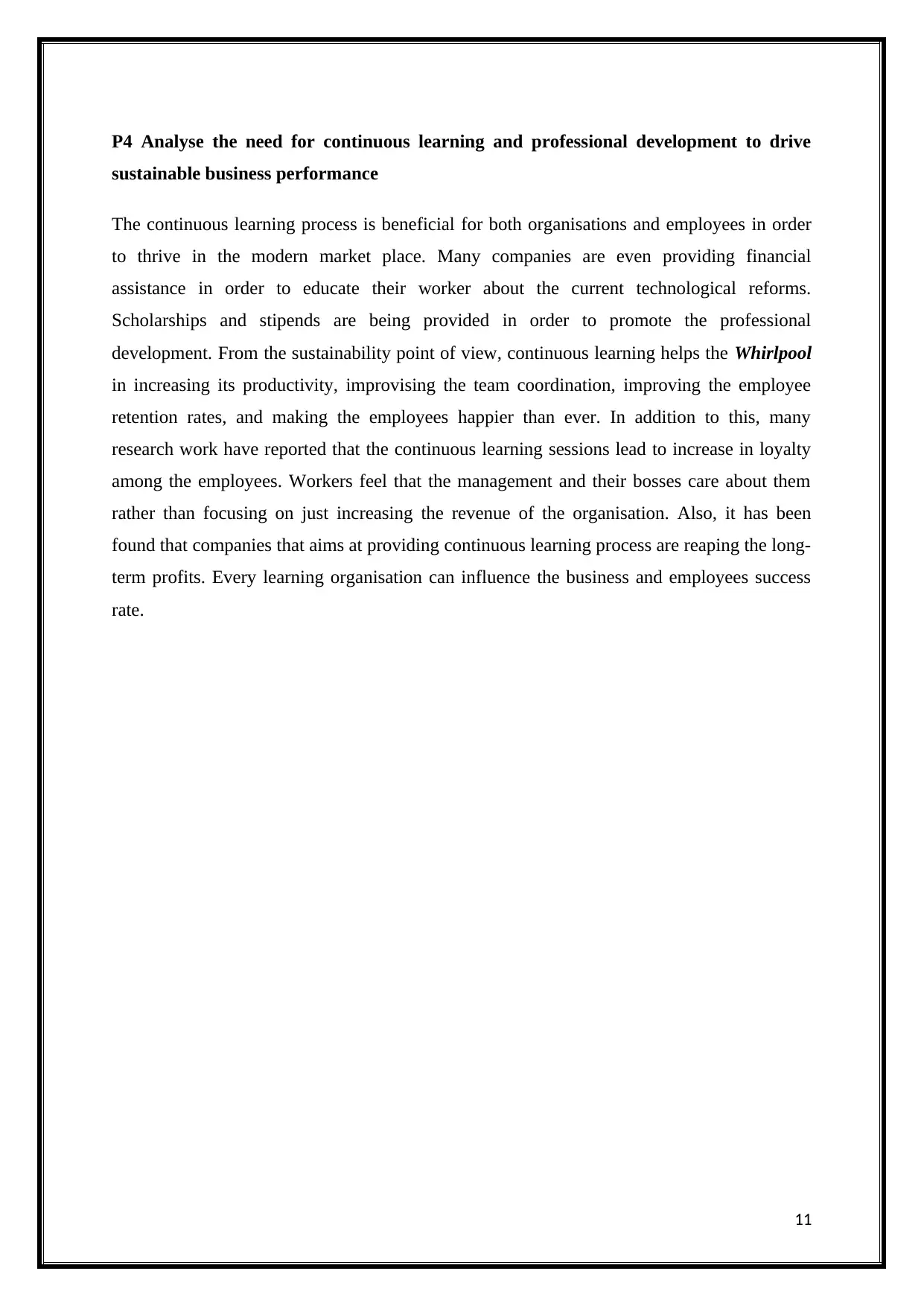
P4 Analyse the need for continuous learning and professional development to drive
sustainable business performance
The continuous learning process is beneficial for both organisations and employees in order
to thrive in the modern market place. Many companies are even providing financial
assistance in order to educate their worker about the current technological reforms.
Scholarships and stipends are being provided in order to promote the professional
development. From the sustainability point of view, continuous learning helps the Whirlpool
in increasing its productivity, improvising the team coordination, improving the employee
retention rates, and making the employees happier than ever. In addition to this, many
research work have reported that the continuous learning sessions lead to increase in loyalty
among the employees. Workers feel that the management and their bosses care about them
rather than focusing on just increasing the revenue of the organisation. Also, it has been
found that companies that aims at providing continuous learning process are reaping the long-
term profits. Every learning organisation can influence the business and employees success
rate.
11
sustainable business performance
The continuous learning process is beneficial for both organisations and employees in order
to thrive in the modern market place. Many companies are even providing financial
assistance in order to educate their worker about the current technological reforms.
Scholarships and stipends are being provided in order to promote the professional
development. From the sustainability point of view, continuous learning helps the Whirlpool
in increasing its productivity, improvising the team coordination, improving the employee
retention rates, and making the employees happier than ever. In addition to this, many
research work have reported that the continuous learning sessions lead to increase in loyalty
among the employees. Workers feel that the management and their bosses care about them
rather than focusing on just increasing the revenue of the organisation. Also, it has been
found that companies that aims at providing continuous learning process are reaping the long-
term profits. Every learning organisation can influence the business and employees success
rate.
11
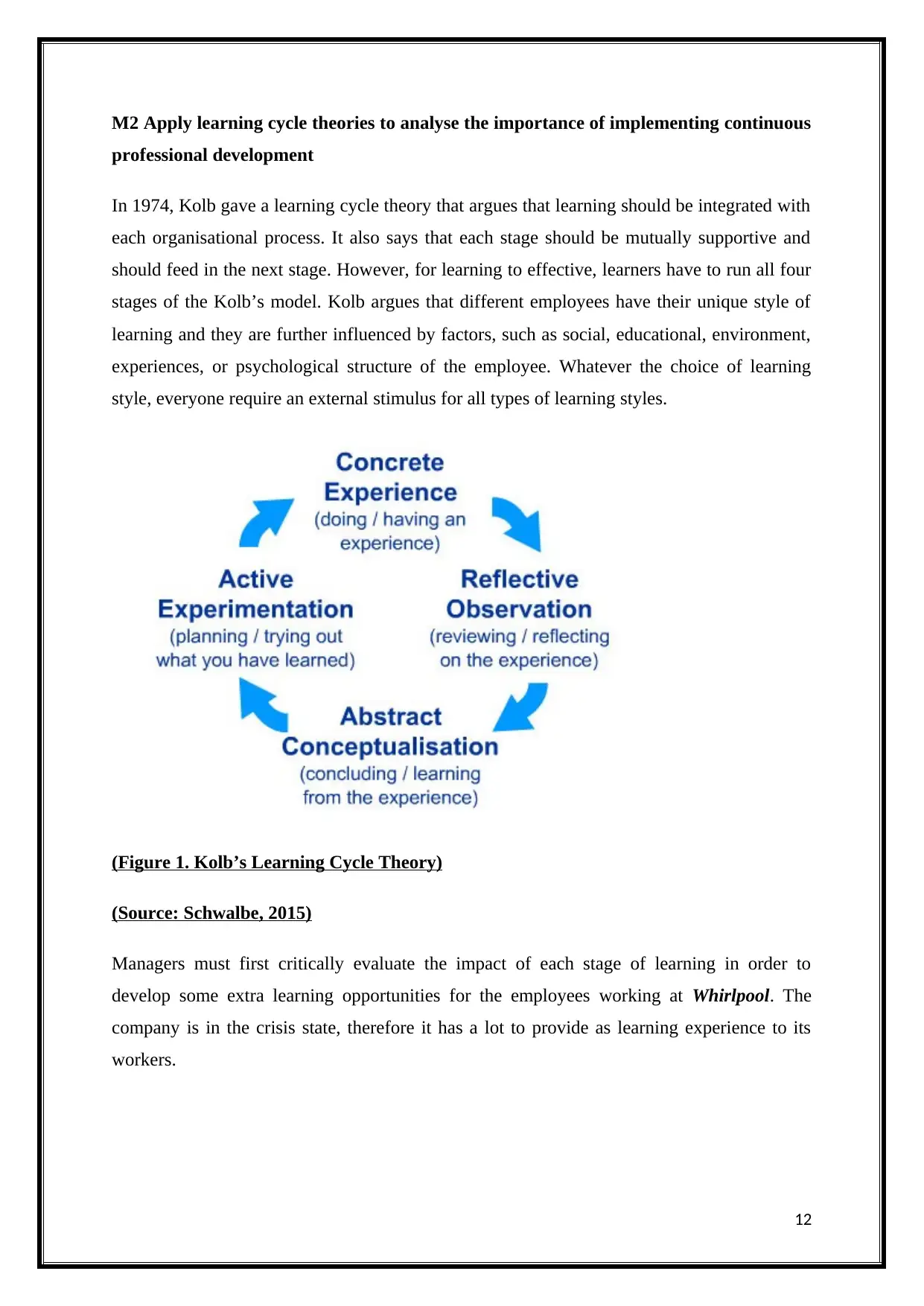
M2 Apply learning cycle theories to analyse the importance of implementing continuous
professional development
In 1974, Kolb gave a learning cycle theory that argues that learning should be integrated with
each organisational process. It also says that each stage should be mutually supportive and
should feed in the next stage. However, for learning to effective, learners have to run all four
stages of the Kolb’s model. Kolb argues that different employees have their unique style of
learning and they are further influenced by factors, such as social, educational, environment,
experiences, or psychological structure of the employee. Whatever the choice of learning
style, everyone require an external stimulus for all types of learning styles.
(Figure 1. Kolb’s Learning Cycle Theory)
(Source: Schwalbe, 2015)
Managers must first critically evaluate the impact of each stage of learning in order to
develop some extra learning opportunities for the employees working at Whirlpool. The
company is in the crisis state, therefore it has a lot to provide as learning experience to its
workers.
12
professional development
In 1974, Kolb gave a learning cycle theory that argues that learning should be integrated with
each organisational process. It also says that each stage should be mutually supportive and
should feed in the next stage. However, for learning to effective, learners have to run all four
stages of the Kolb’s model. Kolb argues that different employees have their unique style of
learning and they are further influenced by factors, such as social, educational, environment,
experiences, or psychological structure of the employee. Whatever the choice of learning
style, everyone require an external stimulus for all types of learning styles.
(Figure 1. Kolb’s Learning Cycle Theory)
(Source: Schwalbe, 2015)
Managers must first critically evaluate the impact of each stage of learning in order to
develop some extra learning opportunities for the employees working at Whirlpool. The
company is in the crisis state, therefore it has a lot to provide as learning experience to its
workers.
12
⊘ This is a preview!⊘
Do you want full access?
Subscribe today to unlock all pages.

Trusted by 1+ million students worldwide
1 out of 22
Related Documents
Your All-in-One AI-Powered Toolkit for Academic Success.
+13062052269
info@desklib.com
Available 24*7 on WhatsApp / Email
![[object Object]](/_next/static/media/star-bottom.7253800d.svg)
Unlock your academic potential
Copyright © 2020–2025 A2Z Services. All Rights Reserved. Developed and managed by ZUCOL.





